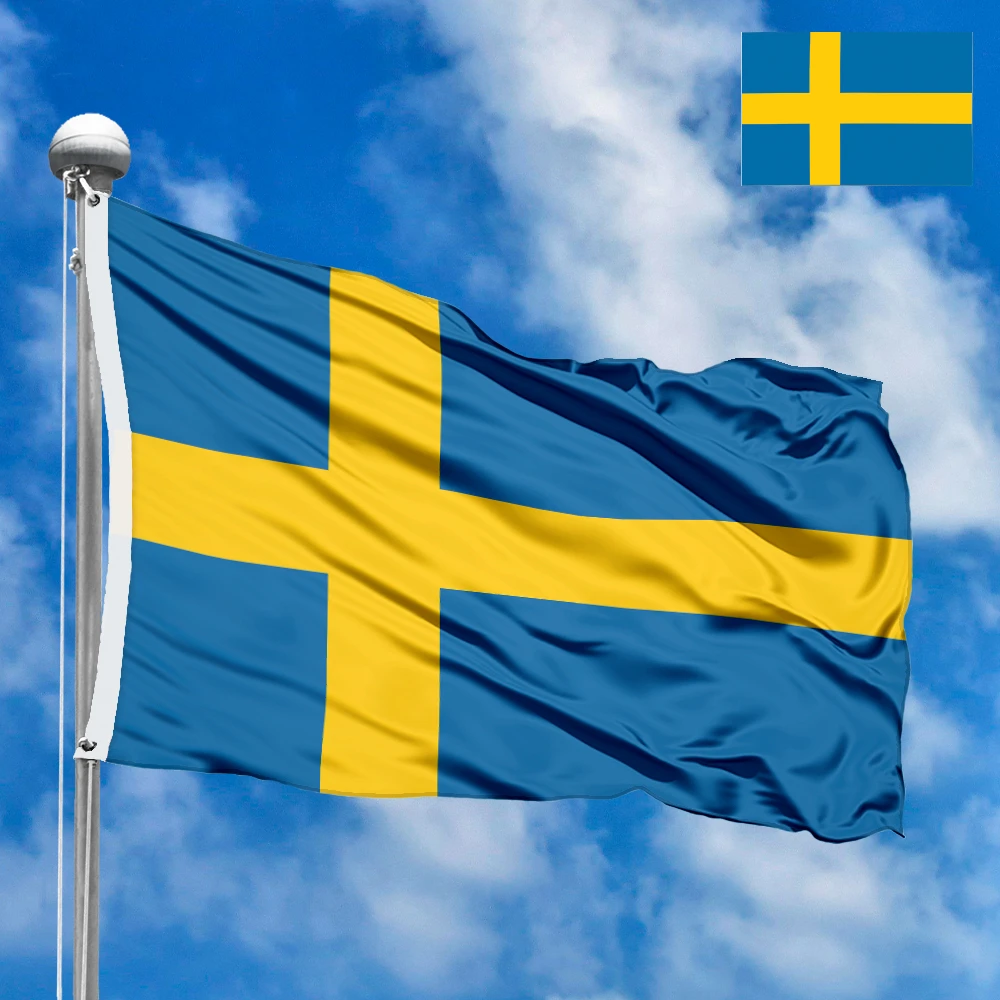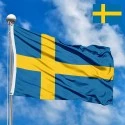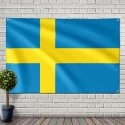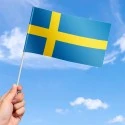The national flag of Sweden, a symbol of profound historical depth and enduring national identity, features a striking design: a yellow Nordic cross on a blue field. This iconic emblem, known formally as the Swedish Flag, is far more than a mere national ensign; it embodies centuries of history, cultural heritage, and the fundamental values cherished by the Swedish people. Its distinctive layout, with the horizontal arm of the cross shifted towards the hoist (left) side, is characteristic of all Nordic flags, signifying Sweden's deep-rooted historical and cultural ties within the Scandinavian region.
The dimensions of the Swedish flag are legally defined to ensure its consistent and respectful display. For the national flag, the proportions are 5:8 (height to width). The blue fields are not uniform in size; those closer to the hoist are typically 4:5, while the fly-side fields are 4:9. The width of the yellow cross arms is precisely half the height of the individual blue fields, ensuring visual harmony and adherence to official standards. The colors themselves are meticulously specified: the blue is officially designated as NCS 4055-R95B (or Pantone 301 C / RGB 0, 82, 147), a medium blue that evokes the vastness of the Swedish sky, the country's numerous lakes, and the deep waters surrounding its coast. The yellow is NCS 0580-Y10R (or Pantone 116 C / RGB 254, 203, 0), a golden hue that symbolizes prosperity, generosity, and the long, bright summer days of Sweden.
The history of the Swedish flag is shrouded in some uncertainty regarding its exact origins, yet its fundamental elements trace back centuries. Blue and yellow have been traditional Swedish colors since at least the mid-13th century, appearing in the coat of arms of the Folkunga dynasty, which ruled Sweden from the 13th to the 14th century. The earliest documented depiction of a yellow cross on a blue background dates to the mid-16th century, specifically to a royal mandate by King Gustav I Vasa in 1569. This mandate stipulated that Swedish standards and flags should always bear a golden cross, believed to be directly derived from the Swedish coat of arms, which features a golden cross dividing a royal shield.
The design of the Swedish flag is widely believed to have been inspired by the Danish flag, the Dannebrog, which also features a Scandinavian cross. This influence is a testament to the complex historical interactions and shared cultural heritage among the Nordic nations. While the exact adoption date of the cross design is debated, its use on Swedish vessels became more consistent by the 1620s, during the reign of King Gustav II Adolf. The specific legal regulations for the national flag, including its current proportions and color definitions, were formally established and adopted on June 22, 1906, after Sweden's separation from the union with Norway in 1905. This legislation cemented the flag's modern appearance and status.
The symbolism of the Swedish flag is multifaceted and deeply resonant for its citizens. The blue background is universally understood to represent truth, loyalty, and justice, values deeply ingrained in Swedish society. It also reflects the serene and expansive natural landscapes of Sweden, from its countless lakes and dense forests to its extensive coastline along the Baltic Sea. The yellow or golden cross is a powerful Christian symbol, indicating Sweden's historical adherence to Christianity and its enduring cultural ties to its Christian heritage. Beyond its religious connotations, the golden color is associated with generosity, prosperity, and the life-giving sunlight that graces the Swedish summers. The cross design itself emphasizes Sweden's belonging to the Nordic community, sharing a common visual language with the flags of Denmark, Norway, Finland, and Iceland. This shared design fosters a sense of regional unity and historical continuity.
For the inhabitants of Sweden, the flag holds immense significance as a unifying symbol of their nation. It evokes a strong sense of national pride and collective identity. On Flag Day, celebrated annually on June 6th (which also coincides with Sweden's National Day, commemorating the election of Gustav I Vasa as king in 1523 and the adoption of a new constitution in 1809), the flag is prominently displayed across the country. It is a day of celebration, reflection, and appreciation for Swedish history, culture, and democratic values. The flag is flown on public buildings, in private homes, and at various events, serving as a constant reminder of the nation's independence, its democratic principles, and its long-standing peace.
The flag represents the continuity of the Swedish monarchy and state, bridging centuries of tradition with modern societal values. It is a visual shorthand for Swedish neutrality, a cornerstone of its foreign policy for over two centuries, and its commitment to peace. During moments of national achievement, such as sporting victories or scientific breakthroughs, the flag is waved enthusiastically, embodying the collective joy and pride of the nation. Conversely, during times of mourning or national reflection, its lowered position speaks volumes about collective sorrow and respect. The flag’s presence in everyday life, from public ceremonies to merchandise, reinforces its role as a pervasive and beloved emblem of all things Swedish, embodying the Swedish spirit of order, innovation, and social welfare.
Interesting facts about the Swedish flag abound. One notable aspect is its protocol for hoisting and lowering. During the period from March 1st to October 31st, the flag may be hoisted no earlier than 8:00 AM. Outside of this period, the flag should be hoisted no earlier than 9:00 AM. It must be lowered at sunset or no later than 9:00 PM, whichever comes first. This precise protocol underscores the deep respect and formality associated with the national symbol. Another interesting point is the flag's influence on other Nordic flags; the Dannebrog served as the inspiration for the Swedish flag, and subsequently, the Swedish flag's design influenced other Scandinavian countries. While the exact legend behind the flag's creation is less defined than some other Nordic flags (like the Danish Dannebrog's mythical descent from the sky), historical records clearly show its evolution from royal and dynastic emblems. The flag's enduring popularity and its appearance in various forms, from official state ensigns with swallowtails (for military and royal use) to simpler rectangular civilian flags, demonstrate its versatility and omnipresence in Swedish society. The fact that the National Day and Flag Day coincide further emphasizes the flag's integral role in the celebration of Swedish nationhood and heritage.
In the demonstration images, full-size flags are shown with proportions of 2:3, and hand-held flags with proportions of 1:2.






 Waving flag
Waving flag
 Sizes:
Sizes:
 Round flag
Round flag
 Sizes:
Sizes:
 Rectangular flag 2:3
Rectangular flag 2:3
 Sizes:
Sizes: